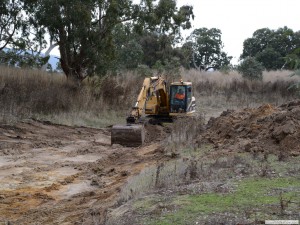Wetland Restoration Case Study 3 – Beaufort District
In this, the third of our early works case studies, we review another completed Nature Glenelg Trust wetland restoration project on a property near Beaufort.
This project was developed to aid the restoration of a five hectare swamp that occurs on a natural watercourse flowing into Fiery Creek. The site provides important water storage in the local drainage network whilst also supporting a high quality remnant red-gum forest that creates important habitat for local bird populations.
Earthworks undertaken by previous owners that included channel excavation and the construction of levee embankments have caused significant modification to the natural wetland area. Since purchasing the property the new owners had noticed changes occurring to the natural inundation zone of the swamp which had historically backed up into the standing red-gums. Concerned that the wetland area was impacted by these past works, the landholders were keen to engage with us to help find a possible solution and develop a remedial response to this issue. After preliminary assessments were undertaken we were able to identify that the recently excavated channels constructed by the previous owners had created a new subsurface drainage pathway for the surface water. The channel excavations had been cut through a shallow depth impervious clay layer in the natural soil structure, subsequently providing an exit route for the surface water to drain through a deeper deposited gravel bed, artificially hastening the loss of water from the wetland system.
On ground works were designed to reduce the depth of the excavated drainage channel by relining the channel bed to effectively reinstate the original confining clay layer. Suitable clay material was sourced on site and a local earthworks contractor was engaged to fill and re-line the drainage channels. To ensure that the capping material was suitably impervious, bentonite clay fines were integrated into the material to increase the sealing effectiveness of the bed material.
This Case Study is the third in a series to illustrate wetland restoration in practice, delivered through Nature Glenelg Trust’s Wetland Restoration Program on Private Land and funded by the Australian Government’s Clean Energy Future Biodiversity Fund.
- Note that this Blog will be also be retained for future reference under the wetland restoration project menu at this address.

Image I. The drainage channel and adjacent levee embankment constructed by the previous property owners.

Image II. The underlying porous coarse sediment bed unearthed by the previous channel excavation. The compacted impervious clay layer had been subsequently removed and used in the adjacent levee embankment.

Image III. The earthworks contractor is shown re-establishing an impervious channel bed. Clay materials obtained from a nearby excavation were mixed with bentonite fines and re-distributed over the underlying coarse sediment layer to form a water tight bedding material.


